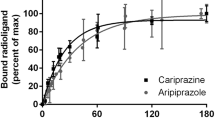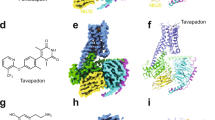Abstract
Receptor binding studies were performed in rabbit neostriatum (caudate-putamen) using the dopamine D2 antagonist [3H]raclopride. Treatment of the membrane preparations with the reducing agent L-dithiothreitol (L-DTT) as well as with the alkylating compoundN-ethylmaleimide (NEM), produced dose-dependent decreases of specific [3H]raclopride binding; the IC50 values were of 3.1 and 1.2 mM, respectively. Saturation experiments showed that the reduction of disulfide (-S-S-) bonds by L-DTT (1 mM) decreased the number of binding sites, with only a slight increase in the affinity. On the other hand, alkylation of sulfhydryl (-SH) groups by NEM (1mM) decreased both receptor number and affinity. The properties of the remaining binding sites were examined in competition curves with the physiological substrate dopamine and the dopaminergic antagonist (+)butaclamol. The IC50 values for (+)butaclamol in control and in L-DTT and NEM treated membranes were between 3.4 and 4.8 nM, with Hill coefficients (nH) of 1, indicating that the remaining binding sites conserved a high affinity for antagonist binding. In the case of dopamine, the curves were shallow (nH 0.45–0.64) and both compounds increased the IC50 from 0.7 μM (control) to 8 μM and 11 μM, for L-DTT and NEM respectively. Iterative analysis revealed that L-DTT produced a very important (>60%) decrease in the number of high-affinity (RH) binding. After NEM, there was a decrease in both the number of (RH) and the affinity (KH) of the high-affinity binding sites, and in the affinity (KL) of the low-affinity sites. These results demonstrate the participation of-S-S- and-SH groups in the agonist conformation of theprimary ligand recognition site of the dopamine D2 receptor. Alternatively,-S-S-and-SH groups could be related to the coupling of the primary ligand recognition protein with adenylate cyclase by means of an inhibitory type ofG protein.
Similar content being viewed by others
References
Kebabian, J., and Calne D. B. 1979. Multiple receptors for dopamine. Nature 277:93–96.
Seeman, P. 1980. Brain dopamine receptors. Pharmacol. Rev. 32:229–313.
Creese, I., Sibley, D. R., Hamblin, M. W., and Leff S. E. 1983. The classification of dopamine receptors: relationship to radioligand binding. Annu. Rev. Neurosci. 6:43–71.
Dearry, A., Gingrich, J. A., Falardeau, P., Fremeau, R. T. Jr., Bates, M. D., and Caron, M. G. 1990. Molecular cloning and expression of the gene for the human D1 dopamine receptor. Nature 347:72–76.
Zhou, Q.-Y., Grandy, D. K., Thambi, L., Kushner, J. A., Van Tol, H. H. M., Cone, R., Prignow, D., Salon, J., Bunzow, J. R., and Civelli, O. 1990. Cloning and expression of human and rat D1 dopamine receptors. Nature 347:76–80.
Sunahara, R. K., Niznik, H. B., Weiner, D. M., Stormann, T. M., Brann, M. R., Kennedy, J. L., Gelernter, J. E., Rozmahelli, R., Yang, Y., Israel, Y., Seeman, P., and O'Dowd, B. F. 1990. Human dopamine D1 receptor encoded by an intronless gene on chromosome 5. Nature 347:80–83.
Grandy, D. K., Marchionni, M. A., Makam, H., Stofko, R. E., Alfano, M., Frothingham, L., Fischer, J. B., Burke-Howie, K. J., Bunzow, J. R., Server, A. C., and Civelli, O. 1989. Cloning of the cDNA and gene for a human D2 dopamine receptor. Proc. Natl. Acad. Sci. USA 86:9762–9766.
Stormann, T. M., Gdula, D. C., Weiner, D. M., and Brann, M. R. 1989. Molecular cloning and expression of a dopamine D2 receptor from human retina. Mol. Pharmacol. 37:1–6.
Chio, C. L., Hess, G. F., Graham, R. S., and Huff, R. M. 1990. A second molecular form of D2 dopamine receptor in rat and bovine caudate nucleus. Nature 343:266–269.
Sokoloff, P., Giros, B., Martres, M.-P., Bouthenet, M.-L., and Schwartz, J.-C. 1990. Molecular cloning and characterization of a novel dopamine receptor (D3) as a target for neuroleptics. Nature 347:146–151.
Van Tol, H. H. M., Bunzow, J. R., uan,.-C., Suhanara, R. K., Seeman, P., Niznick, H. B., and Civelli, O. 1991. Cloning of the gene for a human dopamine D4 receptor with high affinity for the antipsychotic clozapine. Nature 350:610–614.
Suhanara, R. K., Guan, H.-C., O'Dowd, B. F., Seeman, P., Laurier, L. G., Ng, G., George, S. R., Torchia, J., Van Tol, H. H. M., and Niznick, H. B. 1991. Cloning of the gene for a human dopamine D5 receptor with higher affinity for dopamine that D1. 1991. Nature 350:614–619.
De Camilli, P., Macconi, D., and Spada, A. 1979. Dopamine inhibits adenylate cyclase in human prolactin-secreting pituitary adenomas. Nature 278:252–254.
McDonald, W. M., Sibley, D. R., Kilpatrick, B. F., and Caron, M. G. 1984. Dopaminergic inhibition of adenylate cyclase correlates with high affinity agonist binding to anterior pituitary D2 dopamine receptors. Mol. Cell. Endocrinol. 36:201–209.
Onali, P., Olianas, M. C., and Gessa, G. L. 1985. Characterization of dopamine receptors mediating inhibition of adenylate cyclase activity in rat striatum. Mol. Pharmacol. 28:138–145.
De Lean, A., Kilpatrick, B. F., and Caron, M. G. 1982. Dopamine receptor of the porcine anterior pituitary gland. Evidence for two affinity states discriminated by both agonists and antagonists. Mol. Pharmacol. 22:290–297.
Sibley, D. R., De Lean, A., and Creese, I. 1982. Anterior pituitary dopamine receptors. Demonstration of interconvertible high and low affinity states of the D-2 dopamine receptor. J. Biol. Chem. 257:6351–6361.
Wreggett, K. A., and Seeman, P. 1984. Agonist high-and low-affinity states of the D2-dopamine receptor in calf brain. Partial conversion by guanine nucleotides. Mol. Pharmacol. 25:10–17.
Grigoriadis, D., and Seeman, P. 1985. Complete conversion of brain D2 receptors from high-to low-affinity state for dopamine agonists, using sodium ions and guanine nucleotide. J. Neurochem. 44:1925–1935.
Reader, T. A., Boulianne, S., Molina-Holgado, E., and Dewar, K. M. 1990. Effects of monovalent cations on neostriatal dopamine D2 receptors labeled with [3H]raclopride. Biochem. Pharmacol. 40:1739–1746.
Cleland, W. W. 1964. Dithiothreitol, a new protective reagent for SH groups. Biochemistry 3:480–482.
Quennedy, M.-C., Bockaert, J., and Ruout, B. 1984. Direct and indirect effects of sulfhydryl blocking agents on agonist and antagonist binding to central α1− and α2−adrenoceptors. Biochem. Pharmacol. 33:3923–3928.
Reader, T. A., Brière, R., and Grondin, L. 1986. Alpha-1 and alpha-2 adrenoceptor binding in cerebral cortex: role of disulfide and sulfhydryl groups. Neurochem Res. 11:9–27.
Stadel, J. M., and Lefkowitz, R. J. 1979. Multiple reactive sulfhydryl groups modulate the function of adenylate cyclase coupledbeta-adrenergic receptors. Mol. Pharmacol. 16:709–718.
Moxham, C. P., and Malbon, C. C. 1985. Fat cell β1−adrenergic receptor: structural evidence for existence of disulfide bridges essential for ligand binding. Biochemistry 24:6072–6077.
Sidhu, A., Kassis, S., Kebabian, J. W., and Fishman, P. H. 1986. Sulfhydryl group(s) in the ligand binding site of the D-1 dopamine receptor: specific protection by agonist and antagonist. Biochemistry 25:6695–6701.
Braestrup, C., and Andersen, P. H. 1987. Effects of heavy metal cations and other sulfhydryl reagents on brain dopamine D1 receptors: evidence for involvement of a thiol group in the conformation of the active site. J. Neurochem. 48:1667–1672.
Dewar, K. M., and Reader, T. A. 1989. Specific [3H]SCH23390 binding to dopamine D1 receptors in cerebral cortex and neostriatum: role of disulfide and sulfhydryl groups. J. Neurochem. 52:472–482.
Freedman, S. B., Poat, J. A., and Woodruff, G. N. 1982. Influence of sodium and sulphydryl groups on [3H]sulpiride binding sites in rat striatal membranes. J. Neurochem. 38:1459–1465.
Kilpatrick, B. F., De Lean, A., and Caron, M. G. 1982. Dopamine receptor of the porcine anterior pituitary gland. Effects ofN-ethylmaleimide and heat on ligand binding mimic the effects of guanine nucleotides. Mol. Pharmacol. 22:298–303.
Sibley, D. R., and Creese, I. 1983. Regulation of ligand binding to pituitary D-2 dopaminergic receptors. Effects of divalent cations and functional group modification. J. Biol. Chem. 258:4957–4965.
Scheuhammer, A. M., and Cherian, M. G. 1985. Effects of heavy metal cations, sulfhydryl reagents and other chemical agents on striatal D2 dopamine receptors. Biochem. Pharmacol. 34:3405–3413.
Malbon, C. C., George, S. T., and Moxham, C. P. 1987. Intramolecular disulfide bridges: avenues to receptor activation. Trends Biochem. Sci. 12:172–175.
Köhler, C., Hall, H., Örgen, S.-O., and Gawell, L. 1985. Specificin vitro andin vivo binding of3H-raclopride. A potent substituted benzamide drug with high affinity for dopamine D-2 receptors in the rat brain. Biochem. Pharmacol. 34:2251–2259.
Dewar, K. M., and Reader, T. A. 1989. Distribution of dopamine D1 and D2 receptors in rabbit cortical areas, hippocampus, and neostriatum in relation to dopamine contents. Synapse 4:378–386.
Dewar, K. M., Montreuil, B., Grondin, L., and Reader, T. A. 1989. Dopamine D2 receptors labeled with [3H]raclopride in rat and rabbit brains. Equilibrium binding, kinetics, distribution and selectivity. J. Pharmacol. Exp. Ther. 250:696–706.
Lowry, O. H., Rosebrough, N. J., Farr, A. L., and Randall, R. J. 1951. Protein measurements with the Folin phenol reagent. J. Biol. Chem. 193:265–275.
Barlow, R. B. 1983. Biodata Handling with Microcomputers. Elsevier Science Publishers, Amsterdam.
Munson, P. J., and Rodbard, D. 1980. LIGAND: A versatile computerized approach for characterization of ligand-binding systems. Ann Biochem. 107:220–239.
McPherson, G. A. 1985. Analysis of radioligand binding experiments: A collection of computer programs for the IBM PC. J. Pharmacol. Methods 14:213–228.
Scatchard, G. 1949. The attractions of proteins for small molecules and ions. Ann. NY Acad. Sci. 51:660–672.
Cheng, Y.-C., and Prusoff, W. H. 1973. Relationship between the inhibition constant (Ki) and the concentration of inhibitor which causes 50 percent inhibition (I50) of an enzymatic reaction. Biochem. Pharmacol. 22:3099–3108.
Stefanini, E., Marchisio, A. M., Devoto, P., Vernaleone, F., Collu, R., and Spano, P. F. 1980. Sodium-dependent interaction of benzamides with dopamine receptors. Brain. Res. 198:229–233.
Duman, R. S., Terwilliger, R. Z., Nestler, E. J., and Tallman, J. F. 1989. Sodium and potassium regulation of guanine nucleotide-stimulating adenylate cyclase in brain. Biochem. Pharmacol. 38:1909–1814.
Herdon, H. 1988. N-Ethylmaleimide inactivates adenylate cyclase-coupled but not presynaptic striatal D-2 receptor systems. Eur. J. Pharmacol. 154:115–116.
Woodruff, G., and Freedman, S. B. 1983. Sulpiride binding in rat striatum-effect of dopamine agonists and sulphydryl group reagents. Acta Pharm. Suec. Suppl. 1:119–129.
Parker, R. B., and Waud, D. R. 1971. Pharmacological estimation of drug-receptor dissociation constants. Statistical evaluation. I. Agonists. J. Pharmacol. Exp. Ther. 177:1–12.
Leatherbarrow, R. J. 1987. Enzfitter, A Non-Linear Regression Data Analysis Program for the IBM PC (and True Compatibles). Elsevier Science Publishers, Amsterdam.
Author information
Authors and Affiliations
Rights and permissions
About this article
Cite this article
Reader, T.A., Molina-Holgado, E., Lima, L. et al. Specific [3H]raclopride binding to neostriatal dopamine D2 receptors: Role of disulfide and sulfhydryl groups. Neurochem Res 17, 749–759 (1992). https://doi.org/10.1007/BF00969008
Accepted:
Issue Date:
DOI: https://doi.org/10.1007/BF00969008




